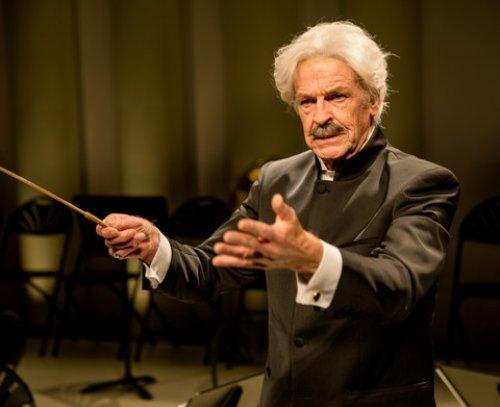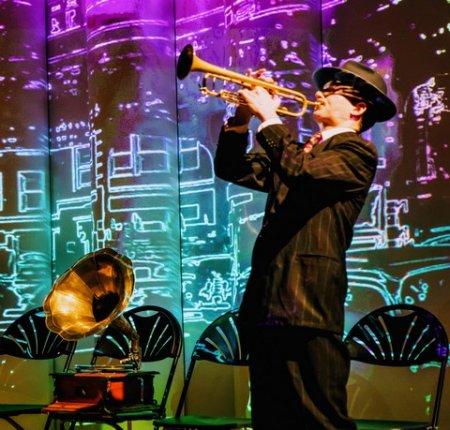Maestro
This multimedia event—a bountiful if somewhat busy look at the late career of conductor Arturo Toscanini—benefits from the contributions of some fine musicians.

John Noble as Arturo Toscanini in a scene from Ensemble for the Romantic Century’s Off Broadway premiere of “Maestro” (Photo credit: Shirin Tinati)
[avatar user=”Mark Dundas Wood” size=”96″ align=”left”]Mark Dundas Wood, Critic[/avatar]With Maestro, Ensemble for the Romantic Century takes a multimedia look at the later career of Italian-born conductor Arturo Toscanini, an international superstar in the music world in the early part of the 20th century, and a stalwart opponent of fascism in the years leading up to World War II.
Eve Wolf’s play is essentially a monodrama, with John Noble portraying the title character. The production is a rich one, both visually and aurally. It features an abundance of live music, performed by a vivacious string quartet (violinists Mari Lee and Henry Wang, violist Matthew Cohen, and cellist Ari Evan), along with a pianist (Zhenni Li) and a trumpeter (Maximilian Morel). In addition, excerpts from historical recordings are heard. Meanwhile, extensive animated projections from designer David Bengali become central to the overall effect. The play is a kaleidoscopic, sense-stimulating experience that seems at times just to avoid becoming a three-ring circus.
The storyline may not fully satisfy all playgoers. It is largely episodic, and the main dramatic conflict is a political one. Toscanini was appalled by the rise of fascism in Italy, in the person of the brutal Benito Mussolini. In the early 1930s, he refused to conduct the fascist anthem, and he turned down Adolf Hitler’s request that he conduct at the Bayreuth music festival. Eventually, he fled Europe and resettled in the United States, living in Riverdale, New York, where he died in 1957 at the age of 89.
The problem for Wolf and director Donald T. Sanders is that, once Toscanini emigrates and takes on the role of “ridiculous spectator” to the war, the major dramatic conflict in Maestro sputters. A secondary, more personal conflict continues, however: Toscanini, a married man, is desperately in love with the much-younger Ada Mainardi, wife of cellist Enrico Mainardi. The conductor maintains a fervent and diligent if apparently somewhat one-sided correspondence with Ada throughout the war years, and he is shattered that she won’t leave her husband and ravaged Europe behind in order to come to America to be with him. Eventually, he repudiates her for failing to reject fascism, but after the war ends, he continues to pine for her.

Mari Lee and Henry Wang on violins, Zhenni Li on piano (with page turner Miles Mandwelle), Ari Evan on cello, and Matthew Cohen on viola in a scene from Ensemble for the Romantic Century’s Off Broadway premiere of “Maestro” (Photo credit: Shirin Tinati)
Wolf and Sanders don’t seem particularly interested in depicting the Toscanini/Mainardi affair as one of history’s great star-crossed romances. The maestro comes off at points as a figure out of a Molière play: a besotted, self-deluding old adulterer. During much of the play, Toscanini communicates to the audience by apostrophizing the absent Ada. At one point as he daydreams about her, he toys with a scarf—apparently a remembrance from her—bringing the cloth to his mouth and all but slathering on it. His adolescent-like behavior tends to put a damper on the enthusiasm we’ve felt for him in the scenes in which we saw his principled stand against totalitarianism.
There’s also the issue of the verbal abuse that he heaps on musicians who don’t measure up to his exacting standards. In a prologue set in New York City in 1938, Toscanini repeatedly barks at the orchestra members (embodied by the audience), telling them that they should be ashamed of themselves for their shoddy musicianship. “When I am dead, I will be more alive than all of you,” he hisses. In 2019, with our patience for entitled, tyrannical geniuses worn thin, this Toscanini will not likely garner full audience sympathy.
All that said, Noble is largely effective in the role. He succeeds in depicting the maestro as a human powder keg, one who, at any given moment, may explode or fizzle—but who can predict which? Less convincing is his depiction of Toscanini’s conducting. This is a tricky business, because the actor’s movements must be synced with recorded passages, inevitably making it seem that he is following the musicians rather than leading them.
The work of the live musicians is impressive. All of the selections performed in the show are from Italian composers, except one piece from Richard Wagner’s Tristan und Isolde and a performance of George Gershwin’s “Rhapsody in Blue” featuring a solo by the crowd-pleasing Morel.

Maximilian Morel on trumpet in a scene from Ensemble for the Romantic Century’s Off Broadway premiere of “Maestro” (Photo credit: Shirin Tinati)
Bengali’s projections work nicely with Beverly Emmons and Sebastian Adamo’s lighting design and the simple, flexible unit set, fashioned by Vanessa James. James also served as costume designer, providing an array of convincing looks for the title character.
The projections serve several purposes. Some of them are, in effect, wordless newsreels: footage of historical events, such as the departure of unfortunate Jewish refugees on the MS St. Louis, which was supposed to land in Cuba but was denied permission to dock there. Other projections give a sense of place, including a depiction of Toscanini’s lovely but lonely Riverdale home. Still others are more atmospheric and/or abstract, working in tandem with the music. In one engaging sequence, black-and-white oranges on wind-tossed branches gradually take on a full spectrum of color, then turn black-and-white yet again, then—finally–dissolve into something undulating and unrecognizable. But some of the animated imagery—such as a cloak that repeatedly shifts shape in mid-air—may fail to impress audiences who’ve grown used to the ever-morphing animated screen-savers on their computers.
One last thing about the projections: perhaps it would be better to reposition the supertitles containing explanatory notes. Currently these pop up occasionally, above the playing area, stage right, and–with everything else going on–it’s easy to miss them. It would be helpful to put them in a more prominent place.
Maestro might also benefit from some minor cutting. While there’s something pleasing about the way the play progresses leisurely, enervation starts to creep in eventually. If the piece were played straight through without intermission, with some of the live musical numbers either deleted or trimmed, the overall effect would likely be stronger.
Maestro (through February 9, 2019)
Ensemble for the Romantic Century
The Duke on 42nd Street, 229 West 42nd Street, in Manhattan
For tickets, call 646-223-3010 or visit http://www.dukeon42.org
Running time: two hours including one intermission






Leave a comment